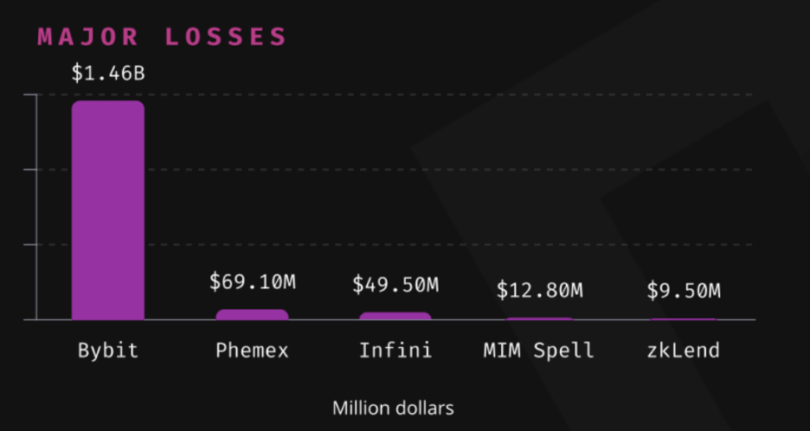Crypto Market Experiences Worst First Quarter in History

The cryptocurrency market encountered its most difficult quarter of 2025 since its inception leading to major events that shaped its history. Multiple unfavorable incidents, including major price drops and unprecedented security failures, have placed pressure on the crypto market stability through an unprecedented system-wide challenge.
Market Performance Shows Decline
Bitcoin (BTC) demonstrated a significant market decline as it served as the primary indicator within the cryptocurrency marketplace. The digital asset ended Q1 2025 as the fourth-worst quarter in history with an 11.86% decrease since 2018. The Bitcoin cryptocurrency lost 35.38% of its value between January 1 and March 31 which decreased its price from $65,000 to $42,000.
Ethereum (ETH) the cryptocurrency which ranks second in market value experienced a loss greater than 40% while its price declined from start to finish in this particular worst quarter. Both XRP and Solana united with Bitcoin through declining values to create a general market retrenchment.
Contributing Factors to the Downturn
The market downturn has multiple established factors, which are mentioned following, making it the worst quarter in history for the industry.
Macroeconomic Uncertainty: Market instability grew stronger after President Donald Trump declared new trade restrictions because they indicated an escalating trade conflict. Risk-averse investors chose to refrain from volatile assets, which includes cryptocurrencies because of this market uncertainty.
Regulatory Scrutiny: The Luna cryptocurrency manipulation case led Galaxy Digital to pay $200 million in settlement with regulatory authorities. New restrictions and regulatory inquiries created uncertainty within the market that raised multiple compliance doubts while suggesting future regulatory changes.
Security Breaches: During this worst quarter the industry resulted in an unprecedented total loss of $1.64 billion from hacking incidents. The Bybit exchange became a victim of a $1.4 billion dollar attack which revealed weaknesses in cryptocurrency infrastructure and caused investor trust to decrease.
Impact on Crypto-Linked Stocks
The economic slide expanded past electronic payment systems to impact the stock values of companies in the crypto space. The Q1 2025 performance of Coinbase experienced its lowest stock price decline at 31% since FTX’s downfall in late 2022. The broader cryptocurrency market sentiment influenced intensive cryptocurrency-related firms such as MicroStrategy and Riot Platforms to sustain significant losses.
During the first quarter of 2025 Coinbase faced its worst quarter in history as its stock value dipped by 33% since January 2. The stock exchange started at $257.20 on January 2 but finished at $172.50 during March 31. The company faced its most severe financial decline since the FTX collapse in late 2022 where stock market fell from $66 to $35.40 leading to a 46.4% reduction.
Coinbase stock prices weakened because the cryptocurrency market faced a general decrease. Bitcoin gave industry clues through its 10% fal, and its digital rival Ether suffered a bigger 45% dip. Two other crypto-related stock market performers such as Galaxy Digital Holdings Ltd. and Riot Platforms Inc. and Core Scientific Inc., together experienced substantial financial declines.
Turnover of the Coinbase stock remains stable despite its recent price drop. Transaction revenue exceeded $750 million during the period from February 11 and subscription and services revenue predictions span $685 to $765 million for the first quarter. Analysts anticipate that Q1 revenue will reach $2.226 billion as estimated EPS stands at $2.18, which represents 32.12% year-over-year growth.
Investor Sentiment and Market Outlook
Current market conditions have produced a restrained approach by investors toward their investments. The technical indicator known as “death cross,” which appears in Bitcoin price charts, indicates an increased possibility of extended negative market trends. The crypto market shows evidence that its relationship with traditional equity markets has strengthened, so macroeconomic indicators now have a greater effect on crypto market movements. Analysts suggest that the industry may be experiencing its worst quarter in history, further intensifying concerns about prolonged downturns.
Near-term market conditions have brought bearish trends but analysts view cryptocurrencies positively for future developmental forecast. Pundits note that the market has a pattern of enduring while forthcoming regulatory standards can create favorable conditions for future growth. The development of blockchain technology together with growing digital assets adoption creates conditions for future quarter market recovery.
Lessons Learned and Moving Forward
The events of Q1 2025 offer several key takeaways for market participants:
A portfolio spread across different assets remains vital because it helps investors protect themselves from volatile cryptocurrency risks. Market risks need proper evaluation through due diligence procedures before investors finalize their investment decisions.
Organizations should implement high-security measures because hacking events are increasing, and users need to select reliable platforms that facilitate trading and storage operations.
The cryptocurrency market needs stakeholders who will maintain constant vigilance alongside adaptive approaches that include being knowledgeable about market developments. As the market evolves, especially amid recent challenges, building economic growth and long-term wealth management strategies becomes essential. Future economic resilience in the crypto market will grow from the understanding and knowledge acquired during crypto’s current assessed difficulties. The value of crypto mining stocks dropped severely, even though companies took strategic business moves — a trend that may reverse during a broader market rebound supported by smarter capital allocation and innovation.
During the first quarter of this year, Hut 8 experienced a major decrease in its stock market value. Hut 8 operates as a well-known data center and cryptocurrency mining company. Starting at $21.10, the company stocks fell to $11.62 during the quarter, which resulted in a loss of 45%. Hut 8 continues to experience a market downturn even after launching with Donald Trump’s sons to establish the world’s largest Bitcoin mining operation with strategic holdings.
Other mining stocks apart from Hut 8 showed similar market declines. During Q1, Hive Digital Technologies experienced a major stock market decline as its value dropped from $2.97 to $1.45, resulting in substantial loss. The stock value of mining hardware manufacturer Canaan Creative dropped by 58.4% as its price declined from $2.11 to $0.8778.
The crypto mining industry remains volatile as measured by its multiple sharp market downturns even while expanding its operations and linking with well-known partners.
Crypto Ecosystem Faces Record Losses in Q1 2025, Immunefi Reports
The cryptocurrency industry suffered staggering losses amounting to $1,635,933,800 across 39 incidents in the first quarter of 2025, according to a report by blockchain security firm Immunefi.

Describing the severity of the situation, Immunefi’s latest findings highlight that Q1 2025 has been the worst quarter for crypto-related hacks in the industry’s history.
The bulk of these losses stemmed from two high-profile breaches targeting centralized exchanges. In January, Phemex experienced a $69.1 million loss, followed by a massive $1.46 billion exploit at Bybit in February.
The total losses recorded in Q1 2025 represent a 4.7-fold increase compared to the same period in 2024, when hackers and fraudsters stole approximately $348.2 million. Security analysts suspect that the North Korean Lazarus Group orchestrated the two largest attacks, seizing $1.52 billion—a staggering 94% of total losses. Immunefi’s Founder, Mitchell Amador, described these events as a historic turning point in crypto security.
“The scale of the Bybit and Phemex breaches, totaling $1.5 billion, underscores how state-backed cybercriminals pose one of the most significant threats to our industry,” Amador stated. “Their ability to compromise well-established, battle-tested platforms reinforces the urgent need for comprehensive security measures that safeguard the entire ecosystem and prevent catastrophic breaches before they occur.”
With hacks accounting for 100% of recorded losses, fraud played no role in the Q1 2025 incidents, further cementing cyber intrusions as the dominant risk in the crypto space.


